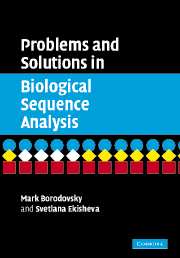Book contents
- Frontmatter
- Contents
- Preface
- 1 Introduction
- 2 Pairwise alignment
- 3 Markov chains and hidden Markov models
- 4 Pairwise alignment using HMMs
- 5 Profile HMMs for sequence families
- 6 Multiple sequence alignment methods
- 7 Building phylogenetic trees
- 8 Probabilistic approaches to phylogeny
- 9 Transformational grammars
- 10 RNA structure analysis
- 11 Background on probability
- References
- Index
5 - Profile HMMs for sequence families
Published online by Cambridge University Press: 06 January 2010
- Frontmatter
- Contents
- Preface
- 1 Introduction
- 2 Pairwise alignment
- 3 Markov chains and hidden Markov models
- 4 Pairwise alignment using HMMs
- 5 Profile HMMs for sequence families
- 6 Multiple sequence alignment methods
- 7 Building phylogenetic trees
- 8 Probabilistic approaches to phylogeny
- 9 Transformational grammars
- 10 RNA structure analysis
- 11 Background on probability
- References
- Index
Summary
Classifying biological sequences into families is one of the major challenges of bioinformatics. In fact, to provide the exact definition of the family (for example, the protein family) is difficult. Even with the introduction of the notion of a conserved in evolution protein domain as a structural determinant of a protein family, to classify multidomain proteins consistently is not a simple task. For practical purposes, nevertheless, it is important to develop efficient computational tools able to assign a protein translated from a newly predicted gene to one of already established families, thus characterizing the protein based on its amino acid sequence alone.
Computational tools of protein characterization have to recognize the familyspecific features in a new protein sequence. Frequently, these detectable common features are manifested as statistically significant structural conservations. The computational tools that are required to solve the classification problem should be able to (i) make use of known structural patterns specific for a given family, (ii) detect the family patterns in the new protein sequence by alignment of the new protein to the family model, and (iii) assess the statistical significance of the detected similarity in order to help correctly identify the true family members.
These three properties of the protein characterization algorithm are similar to the properties of the pairwise sequence alignment algorithm, but there are significant differences. First, the availability of several sequences makes the differential scoring of amino acid matches feasible; with matches (mismatches) in conserved positions receiving higher (lower) scores than scores of similar events in nonconserved positions.
- Type
- Chapter
- Information
- Problems and Solutions in Biological Sequence Analysis , pp. 126 - 161Publisher: Cambridge University PressPrint publication year: 2006



